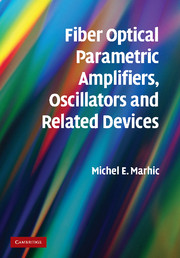Book contents
- Frontmatter
- Contents
- Acknowledgments
- 1 Introduction
- 2 Properties of single-mode optical fibers
- 3 Scalar OPA theory
- 4 Vector OPA theory
- 5 The optical gain spectrum
- 6 The nonlinear Schrödinger equation
- 7 Pulsed-pump OPAs
- 8 OPO theory
- 9 Quantum noise figure of fiber OPAs
- 10 Pump requirements
- 11 Performance results
- 12 Potential applications of fiber OPAs and OPOs
- 13 Nonlinear crosstalk in fiber OPAs
- 14 Distributed parametric amplification
- 15 Prospects for future developments
- Appendices
- Index
- References
9 - Quantum noise figure of fiber OPAs
Published online by Cambridge University Press: 23 March 2010
- Frontmatter
- Contents
- Acknowledgments
- 1 Introduction
- 2 Properties of single-mode optical fibers
- 3 Scalar OPA theory
- 4 Vector OPA theory
- 5 The optical gain spectrum
- 6 The nonlinear Schrödinger equation
- 7 Pulsed-pump OPAs
- 8 OPO theory
- 9 Quantum noise figure of fiber OPAs
- 10 Pump requirements
- 11 Performance results
- 12 Potential applications of fiber OPAs and OPOs
- 13 Nonlinear crosstalk in fiber OPAs
- 14 Distributed parametric amplification
- 15 Prospects for future developments
- Appendices
- Index
- References
Summary
Introduction
In previous chapters we studied wave propagation in fiber OPAs from a classical standpoint, i.e. starting from Maxwell's equations. That approach provides only a partial view of the rich nature of the electromagnetic field, namely its wave nature. However, a complete description of the electromagnetic field requires quantum mechanics. This quantum description of the electromagnetic field (called quantum electrodynamics, or QED) predicts fluctuations in measurable quantities due to the Heisenberg uncertainty principle and sets ultimate limits on the performance of devices such as optical amplifiers. A remarkable result of this theory is that the statistics and thus the noise performance of a system are affected by the quantum statistics of the source and by the physical measurement that is made. Thus a different analysis is needed depending on whether homodyne, heterodyne, or direct detection (where the field simply impinges on a photodiode) is used. Direct detection reveals the particle nature of the electromagnetic field. More specifically, energy arrives in discrete units, called photons, each of which may create an electron–hole pair in a semiconductor photodetector. In particular, the number of photons in an optical pulse can be thought of as a random variable having a mean and a variance. By deriving the mean and variance of the photocurrent that would be present if one performed direct detection of ideal laser light at the input of an optical amplifier and then a similar measurement at its exit, one can quantify the degradation of the signal-to-noise ratio (SNR) caused by the amplifier.
- Type
- Chapter
- Information
- Publisher: Cambridge University PressPrint publication year: 2007



